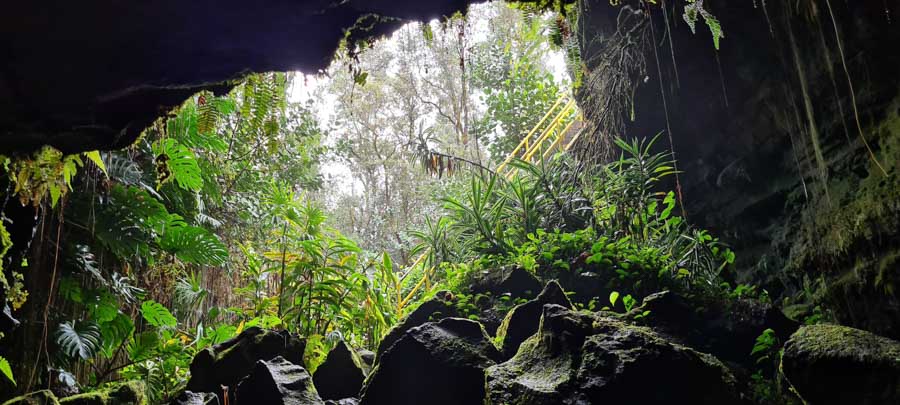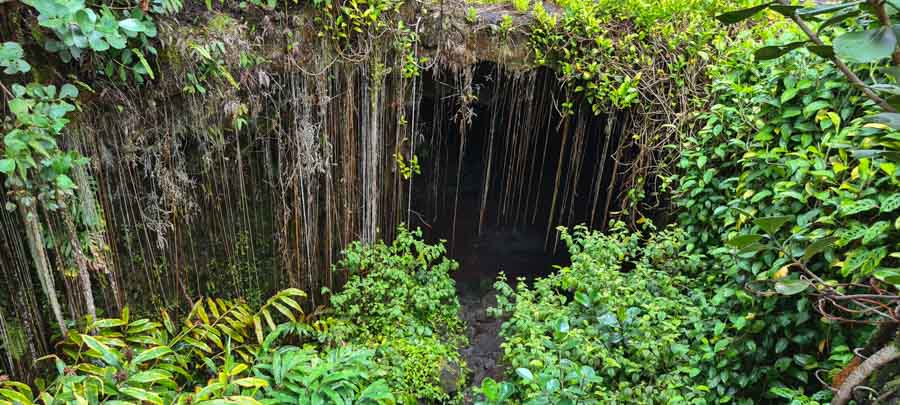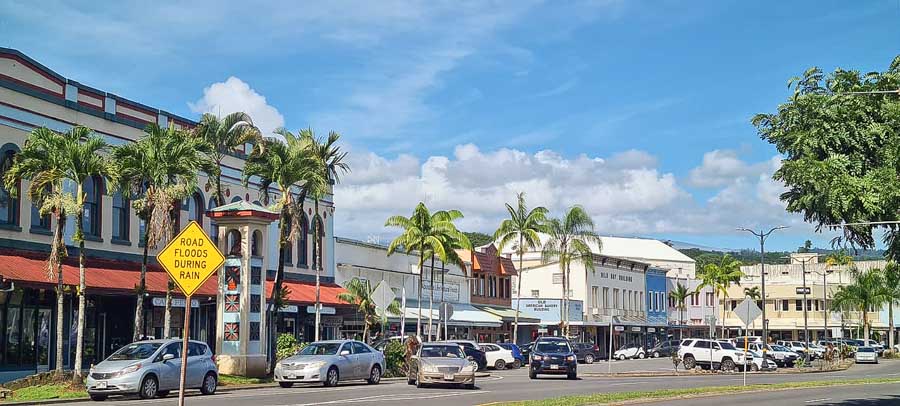Kaumana Caves in Hilo – Pure adventure, exploration and it’s free
Created during the 1881 lava flows into the areas around Hilo, The Kaumana caves are a fascinating place to explore as part of the Kaumana Caves State Park and they are free to visit. I love to visit the caves and exploring a little bit of untamed travel and real without guided tours. You can visit the entrance to the cave areas and a short distance before it actually becomes private property and you cannot go further. (There are no boundary marks to designate private property)
Easy to get to just above Hilo town, the Kaumana Caves are free and fun to explore on your own. But be prepared. I add some important safety measures below for you to know how to visit this site safely and bring proper equipment.

History of the Kaumana Caves
The Kaumana caves were formed by the 1881 lava flows from the flanks of the Moana Loa volcano active during that timeframe that stopped abruptly above Hilo which was a very small town during that timeframe. The lava tube formed as faster lava stays in a channel area while the cooled areas on top create a crust surrounding the tube and acts as an insulator while the hot and fresh lava continues below the surface forcing lava downhill. The molten lava finally erupts at the end and with no fresh lava from the source creates an empty tube or cave as we see today.
The Kaumana caves extend out a distance of over 20 miles on mostly private property from the opening of the park area lava tube. There is actually no clarification on what parts of the tube are public property and which parts are private so enter the caves at your own risk. The entrance to the lava tube is through a flight of stairs to a collapsed portion of the Kaumana Caves and splits into two separate areas to explore and the largest one is on the right hand side.
According to the USGS Hawaiian Volcano Observatory, lava tubes like Kaumana Caves form when “the surface of a lava flow cools and solidifies, while the still-molten interior continues to flow downslope beneath this solid crust” (USGS, Volcano Science Center). The Kaumana Caves specifically formed during the 1881 Mauna Loa eruption, which threatened Hilo before stopping abruptly at what is now the cave entrance (Hawaii Volcanoes National Park Service

Where are the Kaumana Caves Located?
The Kaumana Caves is located at 1492 Kaumana Drive, Hilo, Hawaii 96720 near the 4-mile marker. Parking is on the left side of the road and you cross the street into the park grounds and look for the ladders to the lava tube entrance.
Enter down the flight of stairs to either side of the lava tubes which actually is a collapsed portion of the lava tube itself.
This is the google map here for a quick overview of the site.
Trailhead address: Kaumana Drive, Hilo, HI 96720

Important Safety Guidelines
Before exploring Kaumana Caves, please be aware of these critical safety considerations: for your own safey
1. Sites not monitored – visit the caves at your own risk and they are not monitored or maintained in up-to-date standards
2. Exploration Limits: The public area extends only a short distance into the cave. There are NO markers identifying private property boundaries, so limit exploration to the well-lit entrance areas only.
3. Required Equipment:- At Minimum bring at least two reliable light sources per person – Sturdy closed-toe hiking shoes with good traction – Helmet recommended for head protection – Water and basic first aid supplies
4. Natural Hazards: – The area is completely uneven with no trails, sharp, and slippery surfaces – Complete darkness beyond entrance area – Potential for falling rocks – No cell service inside caves
5. Not Recommended For: – Children under 6 – Visitors with mobility limitations – Solo explorers – Those without proper lighting equipment
Any cave exploration in Hawaii involves inherent risks. The Kaumana Caves have no maintained pathways, guardrails, or emergency services on site.
Check out the details to visiting Kaumana caves below
Details and tips to visiting Kaumana Caves
After descending the ladders to the entrances, there are two openings to explore around the park. You can explore for a short distance but afterwards the tunnels go through private property and should not be explored the entire length of the lava tubes. The crashed opening is lush with gorgeous tree ferns, indigenous plants and other tropical plants that thrive in this wet and beautiful areas surrounding the openings to the cave.
The larger tube is on the right side and is light for a short distance until it gets extremely dark, there are no trails and you have to climb over jagged rocks in the cave.
Exploration Difficulty Rating
The Kaumana Caves experience varies by section:
Entrance Area
(First 50 feet): This start of entry to the cave is relatively easy – Accessible to most visitors. Well-lit from natural skylight. Minimal climbing required.
Opening to interior zone
(50-200 feet): Moderate – Beyond the natural light from the opening, the inside requires flashlights. There are jagged rocks, uneven surfaces and no designated walking pathways. Occasional ducking under low ceilings.
Deep Cave interior
(Beyond 200 feet): Challenging – Complete darkness. Significant climbing over jagged rocks. NOT recommended without proper equipment and experience. NOTE: This area may extend into private property only continue if you are comfortable with conditions and equipment
Amenities on site
You’ll find plenty of parking at the site and walk easily to the site across the street.
There are picnic ground pavilions for relaxing and taking a break before or after.
There are toilets available that are well maintained.
Tips to visiting Kaumana Caves
Bring plenty of bug spray since the area is very lush and wet
Make sure to bring a few light sources if you plan on going into the cave which is very dark
Wear Sturdy shoes since the area is mostly slippery rocks and mud.
It is probably acceptable to just explore a short distance from the entrance where the cave gets extremely dark and you can return back safely to the opening
Enter at your own risks, there are no trails or walkways beyond the stairs down to the caves and there are no boundary signs as to what is private property space within the caves.

Here’s what else to check out in the Hilo area below town

There are a variety of attractions around the city, check out the top things to do in Hilo here for ideas of attractions and popular places to visit around town.
Check out the top places to eat in Hilo town here for any hungry visitors looking for some delicious food venues around town.
Rainbow Falls and the series of waterfalls up the Wailuku River is beautiful and easy to drive to from downtown Hilo and explore.
Coconut Island – close to Lili’uokalani gardens and a short walk through a bridge is this island that used to be a place of refuge in ancient times and is now a popular family-oriented park with two small bridges, a lava tower and gorgeous views looking out on the bay and Hilo town.
HIlo Farmers Market – a popular market and the largest on the island, Hilo Farmers market is a must for fresh produce, delicious snacks and Hawaiian desserts along with vendors selling some of the most popular Hawaiian dishes for take out.
Explore the Japanese and botanical garden at Lili’uokalani Garden in the Banyan Drive area for some love views and visit to this historic garden.
Public walkway to Hilo – you can follow the walkway that travels right next to Hilo bay all the way to downtown Hilo. This is a great way to enjoy the bay and scenery when you want to just walk to town and enjoy the outdoors here
Banyan Drive – a street that is covered with mature banyan trees and planted by historic government and popular figures that visited the park. The trees are mature and create a beautiful canopy on the street where hotels for Hilo accommodations are plentiful
Reeds Bay – a larger bay located on the other side of Banyan drive past the hotels with nice grass areas and beach areas that are family friendly. The water is shallow at this beach which makes it a perfect place for sup paddling and kayaking the surrounding areas of the protected Hilo bay.
For a fun beach day, head out to Carlsmith Beach park or Richardson Ocean Park on the south side of Hilo town.
Canoe club buildings – On Hilo bay, you can check out competing canoe clubs from the area practicing daily after hours and launching into Hilo Bay and doing their drills and other practice techniques for competition meetups around the island and state.
Weather and best time to visit Hilo, Hawaii
The best time to visit Hilo, Hawaii, is during the drier months, which typically run from April to October. This period experiences more sunshine and less rainfall, making it ideal for outdoor activities and sightseeing. The average temperatures during this time range from the mid-70s to low 80s Fahrenheit (24-28°C), providing pleasant weather for exploration.
Hilo’s wet season occurs from November to March when rainfall is more frequent. While Hilo is known for its lush greenery and tropical rainforests, heavy rainfall can limit outdoor activities during this period.
It’s important to note that Hilo’s weather can be unpredictable due to its location on the windward side of the Big Island, where it receives abundant rainfall. Therefore, even during the drier months, be prepared for occasional showers.
To make the most of your visit, consider the drier months for outdoor adventures and exploring Hilo’s natural attractions, including waterfalls, gardens, and the volcano. However, if you prefer fewer crowds and don’t mind occasional rain, the wet season can offer a unique and beautifully verdant experience.
Have you been to Kaumana Caves?
Please share your thoughts and other recommendations in the comments below with your recommendations.
Conclusion to visiting Kaumana Caves in Hilo
Exploring the Kaumana Caves in Hilo is an intriguing and unique experience. These lava tubes offer a fascinating glimpse into Hawaii’s volcanic history, with their dark and mysterious interiors. Visitors can marvel at the natural formations and gain a deeper understanding of the island’s geology.
However, it’s essential to come well-prepared with sturdy footwear, flashlights, and a sense of adventure. The Kaumana Caves provide a captivating adventure for those curious about the geological wonders of Hawaii’s Big Island, making it a worthwhile stop during your Hilo visit.
Thanks for visiting today and checking out this post on Kaumana Cave on This Hawaii Life, hope you check out other posts we share on the site.

Author Bio – Noel Morata
Noel Morata is a freelance photographer/journalist and travel and lifestyle blogger. Having lived in Hawaii for over 15 years, I’ve explored all the historic and cultural sites, tried delicious traditional food, fusion and local style dishes and learned a lot about growing and sustainability.
Hawaii for me is ever changing and I visit many of these places regularly for inspiration, changes that may occur, seasonality and cultural practices. I hope to share with you all the fascinating things and places I’ve learned grown appreciation for and hope that you will find the information helpful to visiting the islands.
I love visiting Kaumana Caves when I have visitors coming to Hawaii, hope this gives you a good look at what the caves are like. While I’ve personally explored Kaumana Caves dozens of times since 2008, I always recommend visitors follow official park guidelines and safety protocols.


0 Comments
Trackbacks/Pingbacks